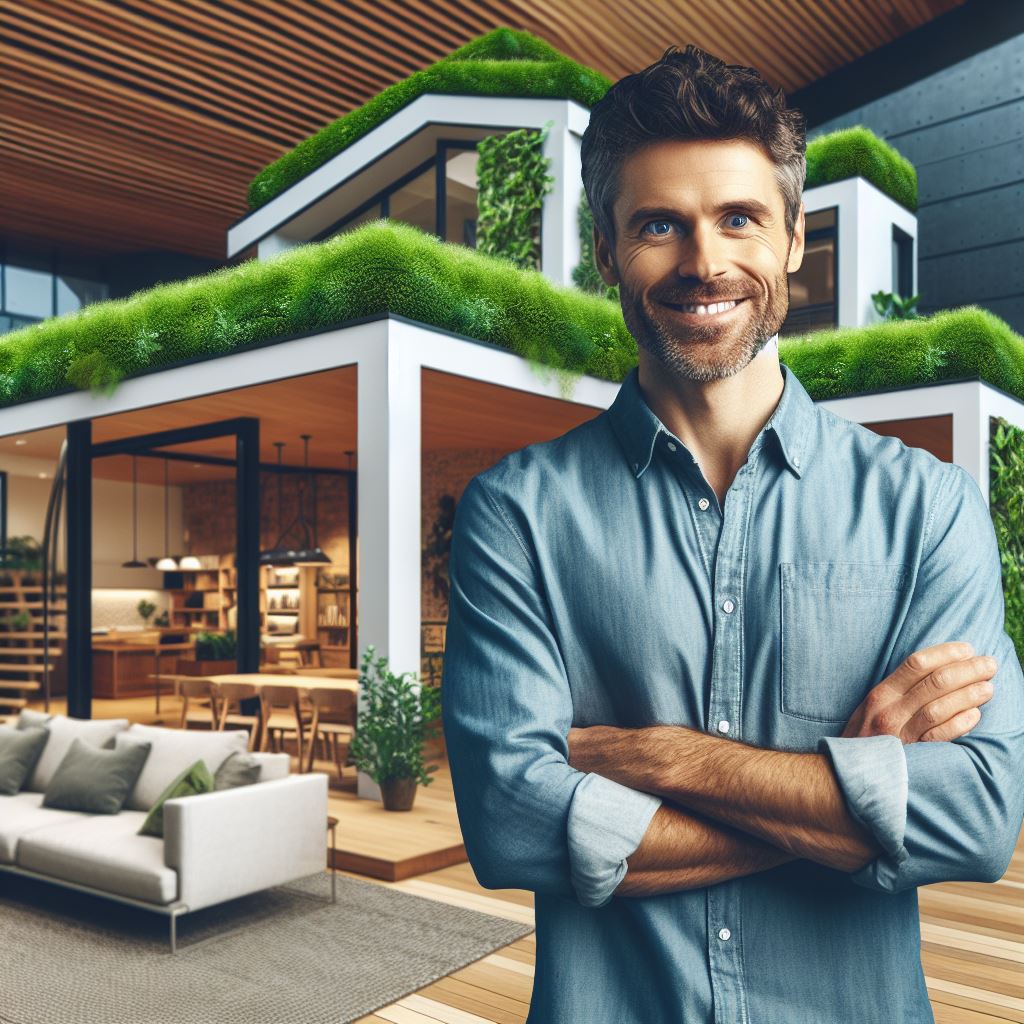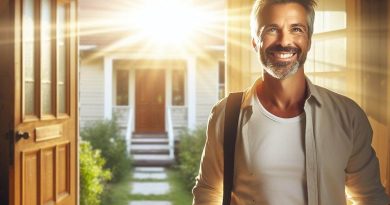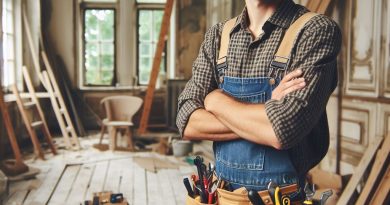Green Roof Benefits for Urban Homes
Last Updated on January 22, 2024
Introduction
Green roofs have emerged as a transformative concept that can revolutionize urban living.
With cities becoming more densely populated, the need for sustainable solutions has never been greater.
Green roofs present a unique opportunity to transform traditional rooftops into thriving ecosystems that offer numerous benefits for both homeowners and the environment.
Living sustainably in urban areas is critical to mitigate the adverse effects of climate change and ensure a healthier and greener future.
Green roofs contribute to this goal by reducing the carbon footprint of urban homes and improving air quality.
These roofs act as natural filters, absorbing harmful pollutants and releasing oxygen, thereby purifying the surrounding air.
The purpose of this blog post is to delve into the various advantages of green roofs specifically for urban homes.
By incorporating a green roof, urban residents can enjoy energy savings by reducing the need for air conditioning and insulation.
The plants and vegetation on green roofs act as a natural insulator, keeping homes cooler in the summer and warmer in the winter.
Additionally, green roofs enhance water management in urban areas.
By absorbing rainwater, these roofs prevent excess runoff, which often leads to flooding and strains stormwater infrastructure.
They also improve the quality of collected rainwater, making it suitable for irrigation and other non-potable uses.
In fact, green roofs provide a multitude of benefits for urban homes, supporting sustainable living and combating environmental challenges.
From mitigating climate change to enhancing energy efficiency and water management, these rooftops offer a promising solution for a greener and more resilient urban future.
Definition and Types of Green Roofs
What green roofs are
Green roofs, also known as living roofs or eco-roofs, are sustainable roofing systems designed to cultivate vegetation atop buildings.
Unlike traditional roofs, which are often impermeable and heat-absorbing, green roofs are composed of layers that support the growth of plants.
These layers typically include a waterproof membrane, a root barrier, a drainage layer, a growing medium, and the vegetation itself.
The primary purpose of green roofs is to enhance environmental sustainability in urban areas.
The different types of green roofs available
Extensive Green Roofs
Extensive green roofs are characterized by their low-maintenance vegetation, such as sedums, grasses, and mosses.
These roofs have a thin layer of growing medium, making them lightweight and suitable for a variety of structures.
Extensive green roofs provide insulation, reduce stormwater runoff, and contribute to biodiversity.
Due to their simplicity and efficiency, they are often chosen for eco-conscious homeowners looking for a practical and environmentally friendly roofing option.
Intensive Green Roofs
In contrast, intensive green roofs feature a thicker growing medium, allowing for a more diverse selection of plants, including shrubs, trees, and even small gardens.
These roofs require more maintenance and structural support due to their weight.
However, the benefits are substantial—intensive green roofs provide enhanced insulation, increased biodiversity, recreational space, and improved air quality.
They are an excellent choice for homeowners seeking a green oasis within the urban jungle.
Semi-Intensive Green Roofs
Sitting between extensive and intensive green roofs, semi-intensive roofs strike a balance between low maintenance and greater plant diversity.
They offer a middle ground for homeowners who desire some greenery without the intensive maintenance requirements of a fully landscaped roof.
With a mix of grasses, wildflowers, and small plants, semi-intensive green roofs provide aesthetic appeal while maintaining practicality.
In short, the diverse types of green roofs cater to varying preferences and practical considerations, offering sustainable solutions for urban homes.
Whether opting for simplicity, luxury, or a balance in between, green roofs contribute significantly to a more eco-friendly and aesthetically pleasing urban environment.
Read: Rainwater Harvesting Systems for Homes
Environmental Benefits of Green Roofs
Improved air quality
Green roofs offer numerous environmental benefits for urban homes.
One of the most significant advantages is improved air quality.
By reducing air pollutants and increasing oxygen production, green roofs effectively contribute to cleaner and healthier urban environments.
Reduction of urban heat island effect
Furthermore, green roofs play a crucial role in mitigating the urban heat island effect.
In densely populated urban areas, high concentrations of concrete and asphalt can lead to increased temperatures.
Green roofs help in lowering surface temperatures, creating a refreshing and cooler microclimate.
This reduction in heat also translates to decreased energy consumption for cooling, making green roofs an energy-efficient solution for urban homes.
Another important environmental benefit of green roofs is stormwater management.
Traditional roofs contribute to excessive stormwater runoff, which can overwhelm urban drainage systems and lead to flooding.
Green roofs, on the other hand, act as natural water filters, absorbing and retaining rainwater.
By reducing stormwater runoff, green roofs help mitigate the risks of flooding in urban areas.
In addition to preventing flooding, green roofs also play a significant role in preventing water pollution.
Rooftops covered with vegetation act as natural filters, removing pollutants and impurities from rainwater before it enters water bodies.
This filtration process helps maintain the quality of water sources and protects aquatic ecosystems.
Lastly, green roofs have the advantage of increased water absorption.
The vegetation and soil on green roofs can absorb a significant amount of rainwater, which would otherwise contribute to stormwater runoff.
This increased water absorption not only helps in preventing flooding but also aids in replenishing underground water sources and maintaining a balanced water cycle.
Stormwater management
In addition, the environmental benefits of green roofs for urban homes are substantial.
Improved air quality, reduction of the urban heat island effect, and effective stormwater management are just a few of the advantages green roofs offer.
By implementing green roofs, urban areas can become more sustainable, greener, and healthier spaces for both humans and the environment.
Read: Eco Lighting Solutions for Your Home
Energy Efficiency and Cost Savings
Insulation and thermal properties
Energy efficiency and cost savings are significant advantages of installing green roofs in urban homes.
By improving insulation and thermal properties, green roofs contribute to a noticeable reduction in energy loss during the winter months.
The insulating layer provided by the vegetation helps to retain heat within the home, reducing the reliance on heating systems and consequently lowering energy consumption.
Moreover, green roofs decrease the need for HVAC (Heating, Ventilation, and Air Conditioning) systems to a certain extent.
As vegetation on the roof absorbs solar radiation and cools the surrounding air through the process of evapotranspiration, indoor temperatures can be regulated naturally, requiring less intervention from HVAC systems.
This not only reduces energy consumption but also contributes to a more sustainable and environmentally friendly living environment.
One of the most appealing aspects of green roofs is the potential cost savings they offer on energy bills.
By enhancing insulation and reducing energy loss, homeowners can experience reduced heating and cooling expenses.
The insulating effect of green roofs can considerably minimize heat transfer through the roof, resulting in lower heating costs during winter.
Similarly, during hot summers, the vegetation layer helps to reduce heat absorption into the living space, reducing the need for air conditioning and leading to lower cooling expenses.
In addition to saving on energy bills, green roofs can also lead to reduced maintenance costs for roofs.
The layer of vegetation provides an extra protective barrier for the roof, shielding it from harsh weather conditions, ultraviolet radiation, and thermal fluctuations.
As a result, the lifespan of the roof membrane is extended, which translates into fewer repairs and maintenance requirements.
Over time, this can result in significant cost savings for homeowners.
Potential cost savings on energy bills
Overall, the energy efficiency and cost-saving benefits of green roofs make them an attractive solution for urban homes.
Not only do they enhance insulation and improve thermal properties, but they also contribute to lower energy consumption, reduced reliance on HVAC systems, and cost savings on heating and cooling expenses.
Furthermore, the additional protection offered by green roofs can lead to decreased maintenance costs for roofs in the long run.
Investing in green roofs not only benefits individual homeowners but also contributes to a more sustainable and eco-friendly urban landscape.
Read: Low-Impact Landscaping for Greener Homes

Improved Health and Well-being
In addition to the numerous environmental benefits, green roofs also offer significant advantages for the health and well-being of urban homeowners.
The concept of incorporating greenery into the design of rooftops has gained popularity due to its potential positive impact on mental health and overall well-being.
Enhanced mental well-being
Greenery promotes relaxation and stress reduction
One of the key benefits of green roofs is the ability to create a peaceful and soothing environment.
The presence of plants and greenery has been shown to have a calming effect on individuals, promoting relaxation and reducing stress levels.
Urban homeowners often face high levels of stress due to the busy and chaotic nature of city living.
Green roofs provide a way to escape from this hustle and bustle, offering a peaceful retreat within the confines of their own homes.
Positive impact on mental health and productivity
Studies have shown that exposure to nature and green spaces can have a positive impact on mental health.
Green roofs not only provide access to nature but also promote a sense of connection to the environment.
This connection has been linked to improved mood, reduced anxiety, and increased overall well-being.
Additionally, being surrounded by greenery has been shown to enhance creativity and productivity, making green roofs an ideal addition for those who work or study from home.
Noise reduction and sound insulation
Absorption of external noise
Urban environments are often characterized by high levels of noise pollution, which can have detrimental effects on our health and well-being.
Green roofs act as natural sound barriers, absorbing external noise and reducing its impact within the home.
This can create a more peaceful and tranquil living environment, allowing homeowners to escape the constant cacophony of the city and enjoy a quieter and more serene atmosphere.
Improved acoustic environment within homes
In addition to reducing external noise, green roofs also contribute to an improved acoustic environment within homes.
The layers of vegetation on the roof can help to absorb and dampen internal noise, creating a more pleasant and comfortable living space.
This is particularly beneficial for those living in apartment buildings or densely populated urban areas, where noise from neighboring units or nearby streets can be a constant source of disturbance.
In essence, green roofs offer a range of benefits for urban homeowners, including improved health and well-being.
The incorporation of greenery into rooftops not only enhances mental well-being by promoting relaxation and reducing stress but also provides noise reduction and sound insulation, creating a more peaceful and tranquil living environment.
With the numerous advantages they offer, green roofs are a valuable addition to urban homes.
Read: Water-Saving Fixtures for Eco Bathrooms
Increasing Biodiversity in Urban Areas
Creation of habitats for plants and animals
Green roofs play a significant role in providing new habitats for various plant and animal species.
With the installation of green roofs, urban homes can become thriving ecosystems that support biodiversity.
These roofs offer a unique opportunity to create habitats for both native and non-native plant species.
Plants such as sedums, wildflowers, and grasses can be easily grown on green roofs, providing shelter and food.
Similarly, green roofs attract a variety of animals, including birds, butterflies, bees, and other beneficial insects.
These habitats contribute to the overall ecological balance and enhance urban biodiversity.
Attracting pollinators and beneficial insects
Green roofs act as magnets, attracting pollinators such as bees and butterflies to urban areas.
The presence of flowers and nectar-rich plants on green roofs provides a food source for these important insects.
By attracting pollinators, green roofs aid in the reproduction of plants and promote urban agriculture.
Beneficial insects, such as ladybugs and lacewings, are also attracted to green roofs.
These insects help control pest populations, reducing the need for harmful pesticides in urban areas.
Attracting pollinators and beneficial insects is crucial for maintaining a healthy urban ecosystem.
Contribution to urban greening and conservation efforts
Green roofs contribute to urban greening by increasing vegetation coverage in densely populated areas.
They provide a much-needed green space in urban environments, where little room is available for traditional gardens.
By adding vegetation to rooftops, green roofs also help reduce the urban heat island effect.
They absorb heat and cool the surrounding air, improving local air quality and reducing energy consumption.
Furthermore, green roofs assist in stormwater management, reducing the burden on urban drainage systems.
Their ability to store rainwater and release it gradually helps prevent floods and protects water quality.
As a result, green roofs are an essential component of urban conservation efforts.
Green roofs bring a multitude of benefits to urban homes, one of which is increasing biodiversity.
By creating habitats for a variety of plant and animal species, green roofs contribute to urban greening and conservation.
They attract pollinators and beneficial insects, promoting the health and reproduction of plants.
Additionally, green roofs aid in urban greening efforts, reducing the urban heat island effect and managing stormwater.
Overall, implementing green roofs in urban areas is a sustainable solution that enhances biodiversity and improves the environment.
Considerations and Challenges of Implementing Green Roofs
Initial setup costs and maintenance requirements
- Installation costs can be high due to the additional materials and labor involved.
- Regular maintenance and inspection are essential to ensure the health and functionality of the green roof.
Structural considerations and weight issues
Before installing a green roof, the structural capacity of the building must be carefully assessed.
The weight of the green roof, including soil, plants, and water, can put stress on the building.
Reinforcements might be necessary to ensure the building can support the additional load.
Potential limitations for older buildings or certain locations
Older buildings may have structural limitations that make it challenging to implement green roofs.
Modifications or additional support may be required, increasing the overall costs.
Certain locations, such as areas with limited sunlight or strong winds, may not be suitable for green roofs.
The climate and environmental conditions must be considered before implementing a green roof.
While green roofs offer numerous benefits for urban homes, there are several considerations and challenges that need to be taken into account.
The initial setup costs and ongoing maintenance requirements can be significant.
Regular inspections and maintenance are crucial to ensure the longevity and functionality of the green roof.
Structural considerations, including the weight of the green roof, must be carefully evaluated to avoid any potential damage to the building.
Older buildings may require additional modifications to meet the necessary structural requirements.
Furthermore, certain locations may have limitations due to environmental factors that make green roofs impractical.
Overall, a thorough assessment of these considerations and challenges is essential before implementing a green roof in urban homes.
Real-Life Examples of Successful Green Roof Projects
These real-life examples of successful green roof projects demonstrate the tremendous benefits they bring to cities and communities.
Examples of cities or buildings with outstanding green roof initiatives
- Chicago City Hall is a pioneer in implementing green roof technology. Its impressive 20,000 square foot green roof helps regulate building temperature and reduces stormwater runoff.
- The Javits Center, one of the largest convention centers in the United States, has embraced sustainability by transforming its 6.75-acre roof into a thriving green space. This project plays a crucial role in mitigating the urban heat island effect and improving air quality in New York City.
- One Central Park in Sydney, Australia, sets a remarkable example with its innovative green roof design. The building’s extensive vegetation offers a visually stunning display, while also promoting energy efficiency and providing habitat for local wildlife.
- The Gardens by the Bay in Singapore is not only a marvel of architectural engineering but also a leader in sustainable practices. Its numerous green roofs contribute to the country’s green infrastructure, absorbing rainwater, and reducing the need for irrigation.
- The Brent Civic Centre in London, known for its eco-friendly features, incorporates an impressive green roof. This sustainable design reduces the building’s carbon footprint and provides insulation, improving energy efficiency throughout the year.
Positive impacts of these projects on the community
- The presence of green roofs in cities significantly improves air quality by trapping dust, pollutants, and harmful gases, such as carbon dioxide.
- Green roofs act as natural insulators, reducing energy consumption for heating and cooling buildings, resulting in lower utility bills for residents and businesses.
- By absorbing and filtering rainwater, green roofs mitigate stormwater runoff, alleviating pressure on drainage systems and reducing the risk of flooding in urban areas.
- Green roofs provide essential habitats for bees, birds, butterflies, and other pollinators, supporting biodiversity and helping to restore ecosystems in urban landscapes.
- Urban green spaces, like green roofs, improve mental health and well-being by offering areas for leisure activities, relaxation, and connection with nature.
The success of these real-life green roof projects proves their effectiveness in addressing environmental concerns, promoting sustainable living, and enhancing the quality of life in urban communities.
By implementing similar initiatives, cities can create a greener, healthier, and more resilient future for all.
Conclusion
Urban living presents a myriad of challenges, from pollution to limited green spaces.
However, the adoption of green roofs emerges as a beacon of hope for a sustainable urban future.
In this concluding section, let’s recap the compelling benefits of green roofs for urban homes and explore how you can contribute to this eco-friendly revolution.
Green roofs offer a host of advantages that extend beyond mere aesthetics.
They act as natural insulators, regulating indoor temperatures and reducing energy consumption.
By mitigating the urban heat island effect, green roofs contribute to a cooler and more comfortable living environment.
Moreover, they play a crucial role in stormwater management, absorbing rainwater and reducing the risk of flooding.
The biodiversity fostered by green roofs promotes a healthier ecosystem, attracting birds, insects, and even small mammals.
Beyond environmental benefits, green roofs enhance the quality of life for urban dwellers.
They provide an oasis of tranquility in the midst of bustling city life, offering residents a space for relaxation and recreation.
The mental and physical well-being of individuals is positively influenced by proximity to nature, and green roofs provide a unique opportunity for city dwellers to connect with the natural world.
As we contemplate the future of our urban landscapes, the implementation of green roofs emerges as a sustainable and pragmatic solution.
The positive impact on energy efficiency, biodiversity, and overall well-being cannot be overstated.
By choosing to invest in green roofs, homeowners contribute to a more sustainable and resilient urban ecosystem.
Ready to embark on your green roof journey? Begin by consulting with professionals who specialize in green roofing.
They can assess the feasibility of implementing a green roof on your property and guide you through the process.
Additionally, stay informed about local regulations and incentives that may support your green roof project.
In the end, the integration of green roofs into urban homes is not just a trend but a crucial step towards a more sustainable and resilient future.
Embrace the green revolution, and let your roof be a symbol of hope for a greener, healthier, and happier urban environment.


